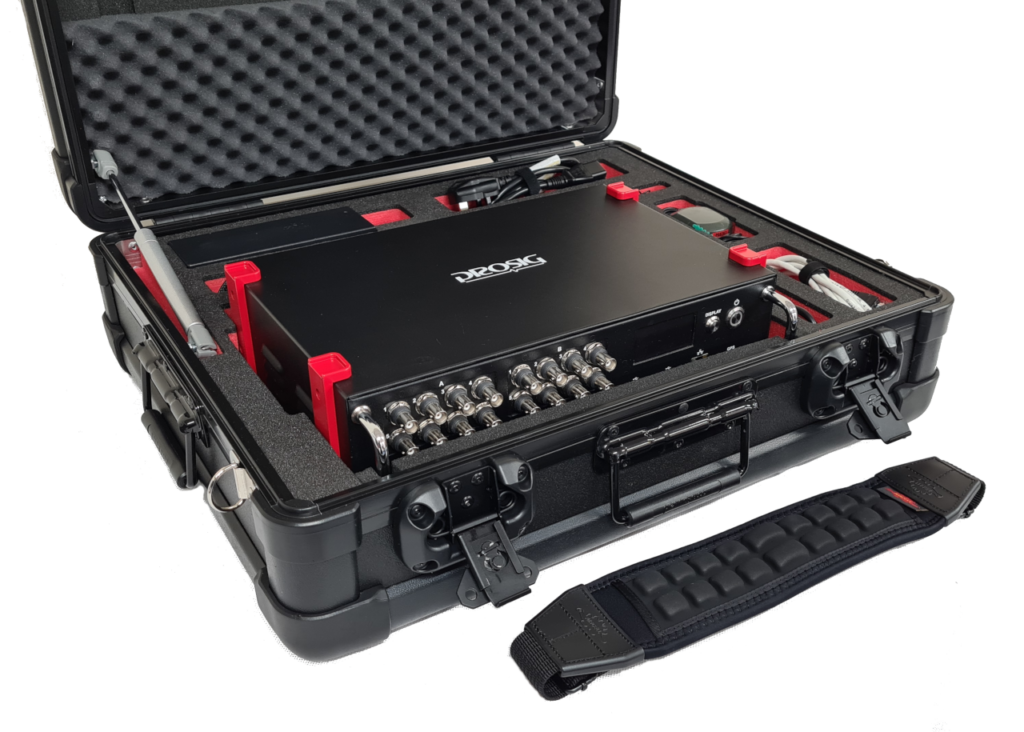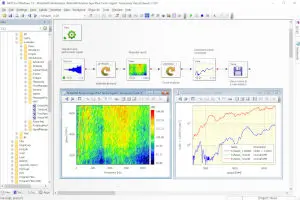The following post on Joseph Fourier is our second in the On The Shoulders of Giants series. It is hard to overstate Joseph Fourier’s importance in the field of sound and vibration measurement and analysis. His work touches almost everything we do. Fourier and his work can be found in numerous posts on the Noise & Vibration Measurement Blog. Read more to discover why.

Introduction
Joseph Fourier, born Jean-Baptiste Joseph Fourier, is a name that resonates through the corridors of mathematics, physics, and engineering. Although most noted for his groundbreaking work in heat conduction, Fourier’s equations have reverberated across disciplines, transforming everything from vibration analysis to acoustics. In this comprehensive look at the life and legacy of Joseph Fourier, we’ll explore his fascinating biography while emphasizing his profound impact on the fields of vibration and acoustic analysis.
Early Life and the Formative Years
Joseph Fourier was born in Auxerre, France, on March 21, 1768. He was the youngest of four children in a family that was soon shattered by the deaths of both parents by the time he was just nine years old. Fourier’s remarkable intellectual abilities quickly became apparent, and at age 13, he was accepted into the École Royale Militaire of Auxerre.
The Revolutionary Period
As a young man, Fourier lived through the tumultuous times of the French Revolution. Although originally training to be a priest, he was pulled into the revolutionary fervour, serving briefly in the local Revolutionary Committee. However, he remained committed to his academic pursuits, gravitating towards the École Normale in Paris to further his education.
The Scientist and the Napoleonic Expedition
After the revolution, Fourier served as a scientific advisor on Napoleon Bonaparte’s Egyptian expedition. The mission aimed to undermine British control of India but was also significant for its scholarly endeavours. Fourier studied the local culture, geography, and history, laying the foundation for Egyptology.
The Analytical Theory of Heat
Joseph Fourier’s “Théorie Analytique de la Chaleur” (The Analytical Theory of Heat) remains a monumental work in the annals of mathematical physics. In this book, Fourier built upon existing theories of heat to present his mathematical formulation for heat diffusion in a solid, known as Fourier’s Law. But what immortalized this work was his introduction of the Fourier Series, a mathematical technique that represents complex functions as infinite sums of trigonometric functions.
The Birth of Fourier Series
The core idea of the Fourier Series emerged from Fourier’s quest to solve heat equations. He discovered that many complex, seemingly irregular functions could be broken down into simpler sinusoidal components. This was groundbreaking because it provided a tool for tackling complex differential equations by representing them as a sum of simpler equations. The Fourier Series allowed scientists and engineers to transform complicated, real-world phenomena into more manageable mathematical problems.
Advertisement
Complexity made simple
From sensors to DAQ to analysis & reporting, Prosig supports your entire measurement chain



Whether you need accelerometers from our colleagues at DJB Instruments, microphones, pressure sensors or something else, Prosig can supply them as part of your system. Or you can use your own. Discover more about the Prosig hardware and software range.
Influence and Inspiration
While Fourier’s work was groundbreaking, it wasn’t created in a vacuum. His theories extended existing studies on heat conduction and wave propagation by earlier scientists like Jean-Baptiste Biot and Jean le Rond d’Alembert. However, Fourier took these existing concepts further by developing mathematical tools that could be generalized across various disciplines, thus laying the groundwork for future research in areas like vibrations and acoustics.
Legacy and Further Work
Fourier’s work was initially met with some scepticism, partly because breaking down arbitrary functions into an infinite sum of sines and cosines was counter-intuitive to many at the time. However, the utility of the Fourier Series became clear as it found applications in other fields. Later, mathematicians and physicists, including Poincaré, Dirichlet, and Riemann, expanded upon Fourier’s theories, validating and extending them to more general conditions.
The mathematical framework laid out by Fourier has enabled generations of engineers and scientists to dissect complex waveforms, whether in the form of vibrations in machinery or sound waves in a concert hall. His work also paved the way for the development of the Fourier Transform. This more generalized form finds applications in modern fields like signal processing, quantum mechanics, and machine learning algorithms.
In summary, Fourier didn’t merely present a solution to a particular problem; he provided a powerful, universal tool that transcended the original context of heat conduction. His Fourier Series became one of the cornerstones of applied mathematics, influencing multiple generations of researchers and practitioners across various scientific endeavours.
Fourier Series in Vibration Analysis
The Fourier Series provided engineers and scientists a robust tool to break down complex vibrations into simpler sinusoidal components. This mathematical framework revolutionized the analysis of mechanical systems. For instance, engineers can now identify natural frequencies and vibration modes, which are crucial parameters in the design of structures like bridges, buildings, and machinery. Before Fourier’s contribution, such analyses were cumbersome and often impractical, especially for complex systems.
Case Study: Automotive Vibration Analysis
Fourier’s mathematical principles are indispensable in the automotive industry, especially when analyzing vibrations. Engineers strive to design vehicles that perform well and offer a smooth and comfortable ride. Understanding and controlling vibrations are crucial to achieving this goal.
To pinpoint issues like engine vibrations, imbalances in rotating components, or resonance in the car’s structure, engineers turn to Fourier analysis. By breaking down complex vibration patterns into simpler sinusoidal waves, they can identify the root cause of problems and work on targeted solutions. For example, identifying a specific frequency that causes discomfort can lead to installing dampers that counteract this frequency, significantly improving the ride quality.
This analysis isn’t just for passenger comfort but also for vehicle safety. Understanding how vibrations propagate through a vehicle can help engineers identify potential weak points that may fail under certain conditions. As a result, Fourier’s work in vibration analysis plays a pivotal role in the design, testing, and refinement of virtually every vehicle on the road today.
Case Study: Earthquake Engineering
The role of Fourier’s mathematical principles in earthquake engineering cannot be overstated. By enabling engineers to dissect complex seismic waves into their individual frequency components, Fourier analysis has revolutionized how structures are designed to withstand earthquakes. This mathematical tool transforms the daunting complexity of earthquake-induced vibrations into manageable data, allowing for highly targeted design and retrofitting efforts. For instance, in seismically active cities like San Francisco and Tokyo, Fourier analysis has guided engineers in reinforcing the vulnerabilities in existing structures, thereby substantially enhancing their resilience to future seismic events.
Fourier’s equations serve a dual purpose: they guide the construction of new, more resilient structures and provide invaluable insights for retrofitting older buildings. By isolating specific frequencies that pose the most risk to a given structure, engineers can prioritize the reinforcement of those areas most susceptible to those frequencies. This targeted approach is cost-effective for upgrading older structures, making them safer without needing complete rebuilding.
Beyond structural engineering, Fourier’s contributions have also fueled advancements in earthquake early-warning systems. These systems utilize Fourier analysis to quickly decompose seismic waves as they propagate, offering valuable seconds or even minutes of warning. While this might seem like a brief span, it is often enough time to save lives and initiate automated processes that can shut down critical infrastructure, thereby minimizing damage. Fourier’s work continues to be a foundational element in our ongoing efforts to mitigate the catastrophic impacts of natural disasters.
Fourier Transform in Acoustic Analysis
Fourier’s work didn’t just stop at series; he also developed what is now known as the Fourier Transform. This mathematical technique allows for the transformation of a function of time (or space) into a function of frequency. In acoustics, this is incredibly powerful. Complex sound patterns can be decomposed into constituent frequencies, making it easier to analyze and manipulate sounds.

Case Study: Modern Music Production
The influence of Joseph Fourier’s work extends into modern music production, shaping how we create, modify, and even perceive sound. The advent of digital audio workstations (DAWs), synthesizers, and various audio effects processors have brought Fourier’s mathematical constructs into the toolkit of musicians and audio engineers. At the heart of these technologies lies the Fourier Transform, a method to convert a signal from its original domain (often time or space) into the frequency domain, providing a new layer of insight and control over sound.
Before the digital age, musicians were limited to analogue methods for manipulating sound, which offered less precision. The Fourier Transform enables precise manipulations in the frequency domain, meaning that artists can now isolate specific frequencies for enhancement or attenuation. For instance, in electronic music, it’s common to boost or cut certain frequencies to achieve a desired sonic texture. In genres where vocals are the focal point, Fourier analysis can be used to cleanly separate the vocal frequencies from the instrumental background, allowing for higher clarity and impact.
Fourier’s techniques also play a crucial role in sound restoration and mastering. Scratches, hisses, and other forms of noise can mar vintage recordings. Fourier analysis can identify and subtract these unwanted sounds without affecting the original performance. The same applies to the mastering process, which aims to create a balanced, coherent piece from multi-track recordings. Engineers can use Fourier methods to analyze the frequency spectrum of each track, making subtle adjustments that can greatly improve the final product.
Moreover, Fourier’s principles have become foundational in developing audio effects like reverb, delay, and pitch correction (commonly known as Auto-Tune). For instance, reverb can be mathematically modelled using Fourier Transforms to create natural-sounding spaces, whether small rooms or large cathedrals. Similarly, Fourier analysis allows pitch correction software to isolate the pitch of a note and adjust it to the nearest semitone, making it possible for nearly anyone to achieve pitch-perfect vocals.
Case Study: Architectural Acoustics
The application of Fourier’s work is exceptionally prominent in architectural acoustics, particularly in the design of performance spaces like concert halls and theatres. Achieving perfect acoustics is an elaborate dance of art and science, involving not only the shape and materials of the structure but also the sound waves’ behaviour within the space.
Acousticians employ Fourier analysis to decompose sounds into their constituent frequencies, allowing them to understand how each frequency interacts with the architectural elements. For example, softer materials might absorb lower frequencies, while harder surfaces might reflect higher frequencies. By analyzing the space in the frequency domain, architects and engineers can make informed decisions on the types of materials to use and where to place sound-reflecting and sound-absorbing elements.
Notably, Fourier analysis was instrumental in the redesign of the Royal Festival Hall in London, where problematic acoustics were dramatically improved. By understanding how sound waves behaved at each frequency, acousticians could make targeted modifications to the hall, significantly enhancing its acoustic performance.
Fourier’s principles enable architects and acousticians to create spaces that look aesthetically pleasing and offer remarkable auditory experiences. The clarity of a singer’s voice, the richness of a symphony, and even the intelligibility of a lecturer in an auditorium can all be optimized thanks to Fourier’s pioneering work.

Later Years and Legacy
Fourier continued contributing to various fields, becoming a professor at the École Polytechnique and a foreign member of the Royal Society in London. When he passed away on May 16, 1830, he left behind a legacy of work that remains foundational in many scientific disciplines.
Conclusion
Joseph Fourier’s groundbreaking theories and mathematical techniques have profoundly impacted our understanding of the natural world, particularly in the fields of vibration and acoustics. His equations serve as fundamental tools for engineers, physicists, and other scientists, aiding in analysing everything from the structural integrity of skyscrapers to the subtle intricacies of a musical performance.
Even today, as we look at advanced fields like quantum mechanics, signal processing, and even artificial intelligence, we find echoes of Fourier’s genius. Indeed, his work provides us with the mathematical language to explore and understand the complex vibrations and sounds that fill our world, ensuring that Fourier’s impact will continue to resonate for generations.
From humble beginnings in a small French town to a lifetime of contributions that have rippled through time, Joseph Fourier’s biography is a testament to the enduring power of curiosity, intellect, and the quest for understanding.
Chris Mason
Latest posts by Chris Mason (see all)
- Rotating Machinery Vibration Analysis: Keeping Your Machines Humming Along - November 27, 2023
- Vibration Control and Isolation: A Comprehensive Guide for Engineers - November 6, 2023
- Modal Analysis in the Real World - October 6, 2023


